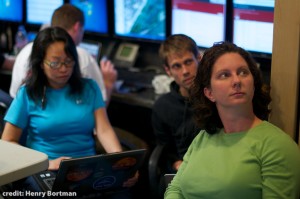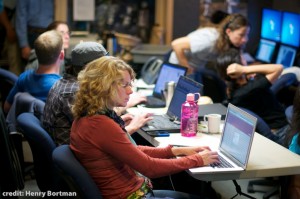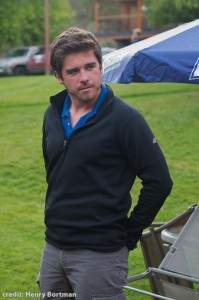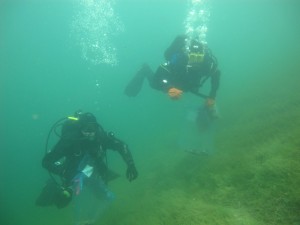By multiple students from Shad Valley at the University of British Columbia
On July 19th and July 20th several members of the PLRP team teleconferenced with Shad Valley students at the University of British Columbia. The video conference included an Astronaut Q&A, presentation by David Pogue, NASA Crew Systems and Crew Survival Operations, and Nick Wilkinson, Web Development, Logistics Consulting and the man behind the infamous MAPPER.
Here is what they have to say.
Space! This word often reminds us of galaxies, black holes, nebulae and our Milky Way. Never would anyone consider a correlation between space and our tangible surroundings. During a span of two days, a group of 52 Shad Valley students are amazed by the revelation that experiments and research conducted on lakes of our very own planet Earth can assist us with analysis of our universe, beyond our solar system. With access to the Pavilion Lake Project’s website, we were able to thoroughly discover the history, mission statement and aims of this project. Furthermore, we were introduced to the gallery and blog of many talented and committed individuals working with the PLRP. The well-established website provided us with many photos, insights and interactive opportunities surrounding the project. During these two days, we had the opportunity to participate in the interactive activities including helping researchers with the filtration of photos of Kelly Lake and Pavilion Lake. Many of us signed up and thoroughly enjoyed contributing to a worthwhile research endeavor, meanwhile gaining precious insight into the importance of ecological unity. We would like to thank the team of the Pavilion Lake Research Project for their diligence and integrity in the pursuit of knowledge. Thank you for all your time and effort put into this presentation and we wish you the best of luck in the continuation of this project.
Warmest regards, Niki, Julie, Edward, and Danielle Shad Valley UBC 2011
During the informative lectures, we learned many new things. The most valuable knowledge we learned was that we can study microbialites that exist under water on earth, and apply it to further development in space. Being able to speak and listen to professionals in different areas of expertise was very eye-opening and broadened our horizons. Learning about DeepWorker submersibles and the MAPPER software allowed us to personally become more involved in the Pavilion Lake Research Project through the photo-tagging activity. Life in space is obviously quite different from life on Earth, and by being able to speak to a veteran astronaut, we gained further insight into these differences such as dealing with zero gravity, eating, sleeping and other regular daily activities.
By Richard Lin, Calvin Kwok and Paul Wong
We think that the work that is being done in Pavilion Lake is really interesting because so much of our world is covered in water, but it remains a huge mystery. Underwater exploration is key in gaining a more complete understanding of our world as a whole. The interactive program is very effective in allowing us to gain better access to first hand information. It is good that the research is not limited solely to the researchers because it allows the general public to get involved in the project and become more knowledgeable about underwater ecosystems. In understanding this information we can begin to comprehend the importance of exploration.
From, Rebecca, Venissa, Patricia
When I’d firstly heard about PLRP, I thought it was like a normal project, but after two sessions, I found out that it was more than that. It was a really big opportunity to know about such project like that, talking to David, and listening to an astronaut’s speech. I have found the answers of my wonderings after that, so it wasn’t wasting of time.
Firas alruwashid
Over the past two days, we have had the pleasure to learn about the fascinating world that exists in Kelly Lake and Pavilion Lake, and the wonderful NASA operation that is currently underway. Before this operation, we had no idea what microbialites were, and how much potential they had in opening our doors to space exploration. In association with this, we found the Mapper website especially creative as it allows us to not only learn about the research that goes on in those lakes, but to interact with the data. However, our favourite experience during this two-day process was getting the astonishing opportunity to interact and correspond with a real NASA astronaut. We learned about the many joys, hardships, and dangers associated with leaving our atmosphere. Overall, this was a truly enlightening experience, and we thank you so much for the brilliant opportunity you provided for us.
Thanks again! Neel, Brian, and Kelly
As members of the Shad community we already have a keen interest in sciences. We are usually exposed to careers such as engineering or research, so it is beneficial to know that there are opportunities to work in other scientific fields. We have learned that there are places here on Earth that are filled with life and yet still unexplored. Exploring depths underwater to further understand space is something we would not have thought of, which is why we found the research done at Pavilion Lake so captivating. The presentation was informative and entertaining, although some technological difficulties made certain parts hard to understand (i.e., the videos). We really appreciated having the opportunity to speak with an astronaut and experts in varied fields.
Catherine & Sophie from QC Shad UBC ‘11
We really enjoyed the talks regarding NASA and the research projects conducted on Pavilion Lake & Kelly Lake. Microbialites were unknown to us before the lectures and learning about them proved to be insightful as it opened our eyes to the many mysteries that have yet to be discovered. The interactive program on the website was fun and educational; and taught us a lot about this newly introduced world of microbialites in a creative way. In addition, speaking to a NASA astronaut gave us the opportunity to listen to the real experiences of being in space – something not very many people have the chance to do. Overall, a very informative and practical experience.
Aaron Vincent, Katy Kemp & Daniel Zhang
Our experience with the PLRP was really informative and intriguing. The use of technology (e.g. Skype and the Mapper) was an innovative way of presenting information and allowing students to be interactive. Before taking part in this presentation, none of us knew about microbialites or the applicable relations between the NASA space program and under-water exploration such as the Pavilion and Kelly Lake projects. Our only issue was some technological malfunctions and lagging that took away from parts of the presentation, but overall, it was a fun and informative presentation in which we all learned a lot. We definitely recommend this presentation to the UBC Shads of 2012, whom will surely be as enthusiastic as we were.
Pia, James, and Amon Shad UBC 2011


 I’m sure many of you have heard the old adage ‘if it ain’t broke, don’t fix it’. Well, sometimes you learn the most when you take something apart and have to put it back together again. We knew that moving to Kelly Lake from Pavilion would provide some challenges and yesterday as our first day of DeepWorker flight operations, we certainly faced a few hiccups. The navigation software had a few bugs and wasn’t talking to the subs. This was problematic as it meant that although we’d still be able to get video from the subs, we wouldn’t be able to track them as they moved around the lake. One of our main goals at Kelly is to map the distribution and morphological variation of the microbialites at the lake and without the ability to track the subs, we wouldn’t be able to identify the location of images that are collected in order to build our map. But, the scientist pilots themselves are also a valuable source of observational information that should not be overlooked and so we decided to go ahead with the flight of at least one of the subs so that we could gather some input about the microbialites and proceed with our science. With that decision made, Sub 7 was away and happily exploring the eastern shore of Kelly Lake. The flight started off under cloudy weather but soon the sun cleared and it must have brought some good luck with it as the navigation software also starting working shortly thereafter and we were able to get tracking for the majority of the flight path. In the end, we didn’t complete our DeepWorker missions quite as planned and Sub 6 was unfortunately not launched. Sometimes science doesn’t go as planned and you need to roll with the punches, we learned a lot and Day 2 of the DeepWorker operations is expected to benefit from these lessons learned and is expected to go a lot smoother. Stay tuned!
I’m sure many of you have heard the old adage ‘if it ain’t broke, don’t fix it’. Well, sometimes you learn the most when you take something apart and have to put it back together again. We knew that moving to Kelly Lake from Pavilion would provide some challenges and yesterday as our first day of DeepWorker flight operations, we certainly faced a few hiccups. The navigation software had a few bugs and wasn’t talking to the subs. This was problematic as it meant that although we’d still be able to get video from the subs, we wouldn’t be able to track them as they moved around the lake. One of our main goals at Kelly is to map the distribution and morphological variation of the microbialites at the lake and without the ability to track the subs, we wouldn’t be able to identify the location of images that are collected in order to build our map. But, the scientist pilots themselves are also a valuable source of observational information that should not be overlooked and so we decided to go ahead with the flight of at least one of the subs so that we could gather some input about the microbialites and proceed with our science. With that decision made, Sub 7 was away and happily exploring the eastern shore of Kelly Lake. The flight started off under cloudy weather but soon the sun cleared and it must have brought some good luck with it as the navigation software also starting working shortly thereafter and we were able to get tracking for the majority of the flight path. In the end, we didn’t complete our DeepWorker missions quite as planned and Sub 6 was unfortunately not launched. Sometimes science doesn’t go as planned and you need to roll with the punches, we learned a lot and Day 2 of the DeepWorker operations is expected to benefit from these lessons learned and is expected to go a lot smoother. Stay tuned!
 By Jennifer Biddle PhD- Researcher at University of Delaware
By Jennifer Biddle PhD- Researcher at University of Delaware
 by Joe Russell – PhD student from University of Delaware studying Microbiology
by Joe Russell – PhD student from University of Delaware studying Microbiology